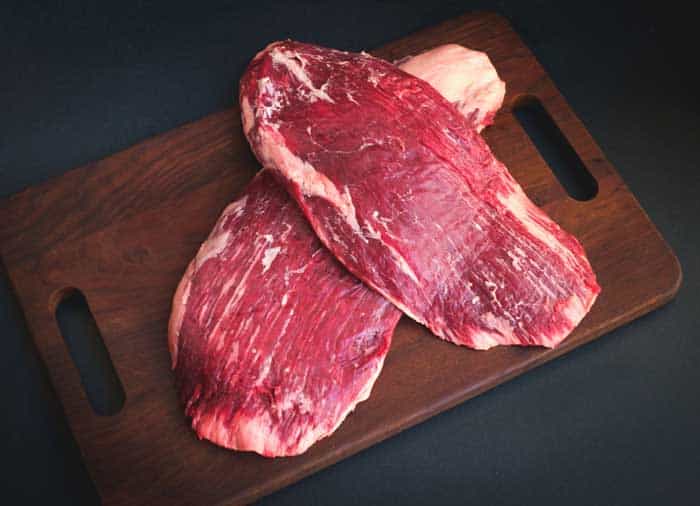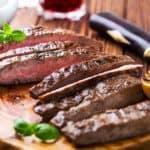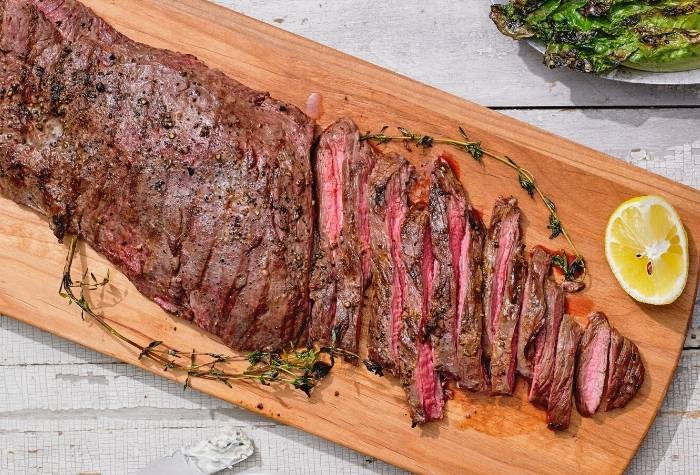Flank and skirt steak are two amazing tasting meats. But which one is best? Find out the differences so you know which one to use for your next BBQ cook-off.

Both are tough, beefy strips of meat that are great straight off the grill. Also, both are criminally overlooked by a lot of chefs.
But what are the differences between flank steak and skirt steak?
Both are long, strange-looking cuts of meat, and a lot of the time the two are often used interchangeably. So is there actually a difference?
The main difference between flank steak and skirt steak is how tough they are. Skirt steak is tougher thank flank, and carries a more intense flavor. This means that it can only be cooked as rare or medium-rare, and is usually best seared. If you prefer your steak well done or tender then I advise going for flank.

What is flank steak?
Flank steak is taken from the bottom abdominal area of the cow. Being the abdominal, this means that beef flank steak is rich in muscle content and full of tough muscle fibers.
What does mean for the meat though? Well this makes the cut of meat very lean, and tough.

It tends to be wider and thicker than skirt steak, and is definitely on the tough side. This toughness makes it especially important that its thinly sliced and cut against the grain.
It carries an intense and rich beef flavor. However it goes really well with marinades, which do help to tenderize it.
Cooking quickly and at high temperatures is the best way to get the most out of flank. It goes well grilled or seared, and even prepared as reverse seared flank steak.
It’s usually sold as an entire muscle, and this will typically weigh around 2 pounds.
FLANK STEAK RECIPES

What is skirt steak?
Skirt steak is taken from the diaphragm muscle of the cow. Not too far from the abdominal of the cow, where the flank is sourced from. Beef skirt steak is also long, tough, and lean, so it’s easy to see why it sometimes gets confused with flank steak.
Don’t be caught off guard if you’re asked if you prefer ‘inside skirt’ or ‘outside skirt’. The truth is that there isn’t much difference between either of them.

Outside cuts come from the outside of the chest wall, running between the 6th and 12th rib of the cow. It sometimes comes with a thick membrane on it, which is actually the diaphragm.
Inside skirt comes from the lower end of the ribs , and is actually cut from inside the animal (hence the name).
Outside skirt is a little bit thicker than inside, and tends to have a more consistent shape. Inside on the other hand is thinner and will often start to shrink as you cook it and the muscle fibers tighten.
Because outside skirt is thicker and more uniform in shape, this is often what is served by restaurants and butchers as a default.
Skirt steak is actually made up of more tough muscle fibers than flank. Not only does this impact on its texture, but it also means it carries a much more intense flavor.
This tough composition also means that it can only be cooked as rare or medium-rare. Anything well done and it’ll be practically inedible.
It’s best seared or grilled, which makes it great for fajitas or stir fry, and also needs to be cut against the grain to efficiently pull apart its tough fibers.
Skirt Steak Recipes
- Brazilian Skirt Steak with Golden Garlic Butter
- Grilled Balsamic Skirt Steak
- Grilled Beef Skirt Steak With Onion Marinade
- Grilled Skirt Steak With Mojo Marinade Recipe
Why cut steak against the grain?
You might have seen a lot of BBQ writers discuss cutting against the grain, particularly when mentioning beef.
Both flank and skirt are made up of very tough and resilient muscle fibers. When meats contains these tough fibers it can make serving and eating them really hard work.
We can separate and break down these fibers more efficiently by cutting against the grain. This won’t ruin the meat, but will help keep it tender and make it easier to eat, as well as slice into thin slices.
Difference in meat structure
One big difference between the two is their grain structure, and how this can affect how you prepare the meat.
Flank steak has very clearly defined fibers. This gives us an easy job when it comes to trying to slice against the grain.
However, the fibers are quite close together, which means it can be difficult for added flavors like marinade to penetrate the meat fully.
Skirt steak also boasts a well defined fiber and grain structure, but the key difference is that the fibers aren’t quite as tightly knit. This means that the meat responds much better to marinades.
How to grill flank & skirt steak
Both flank and skirt steaks are thin, flat cuts. Because of their toughness they’re best enjoyed seared and medium-rare or rare. BBQ tricks like indirect grilling don’t really work on these cuts, just because the flesh is so difficult to penetrate.
Simply cook it directly over the grill, and look to sear it to add some beautiful grill marks down the sides of the meat.
Skirt steak ends to be thinner than flank, so will typically only need about 3 minutes per side when being grilled. Flank on the other hand will need about 5 minutes per side. Aim for an internal temperature of 130F for both steaks. If you don’t have one already, be sure to invest in a good meat thermometer.
What is the difference between skirt steak and flank steak?
Both skirt and flank are active muscles that do a lot of work during the lifespan of a cow. This means that both cuts are lean and tough, and contain less fat than more common beef cuts like ribeye or tenderloin. For this reason, they are both rich in flavor and can be a bit too strong for some people’s tastes.
Now that we’ve taken a deep look at each of the two beef cuts, we can say that the four main differences are:
- Muscle content: Skirt steak is rich in muscle fibers, which makes it tougher and with a more intense flavor than flank
- Preparation: Skirt steak should only be served rare or medium-rare, and is best seared
- Location on the cow: Flank steak comes from the bottom abdominal area of the cow, whereas the skirt comes from the diaphragm muscle.
- Appearance: Flank steak is wider and thicker than skirt
My opinion
For me, I always go flank. It does tend to cost a little more, but in return you get a larger, more tender cut of beef that can be used in so many types of bbq. It’s packed full of flavor and has provided me with more grilling cook-offs than I can even remember.










